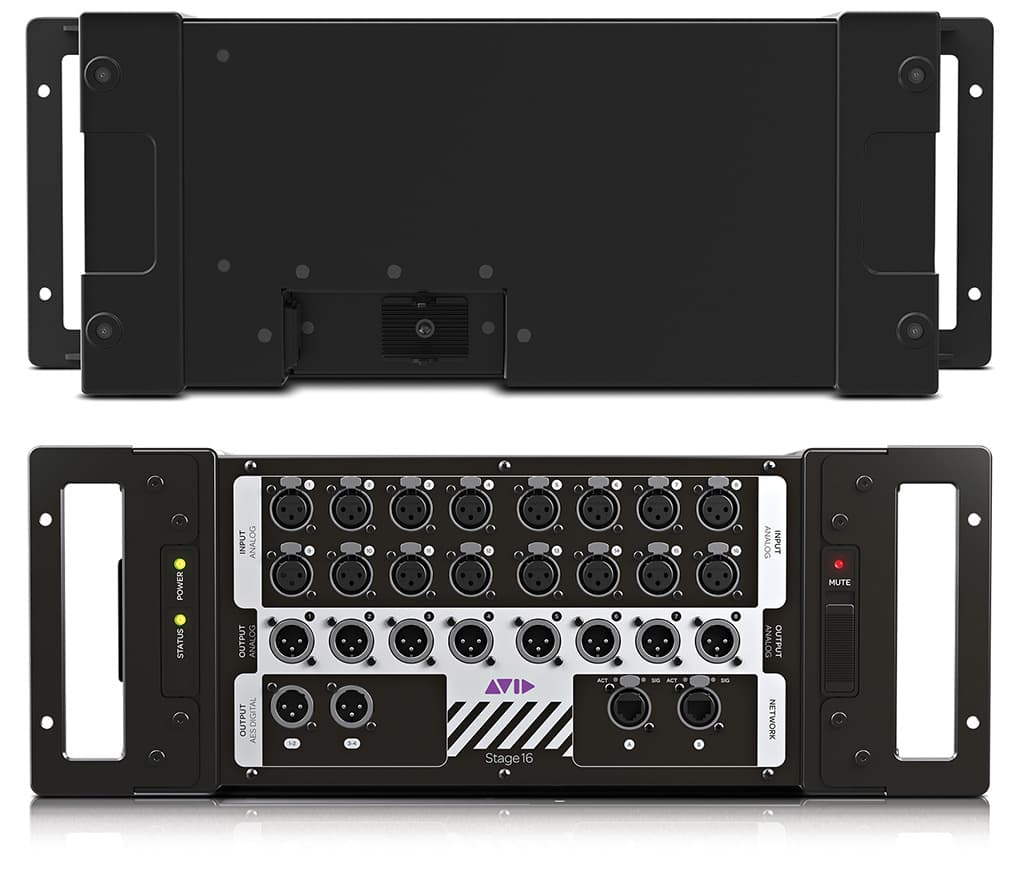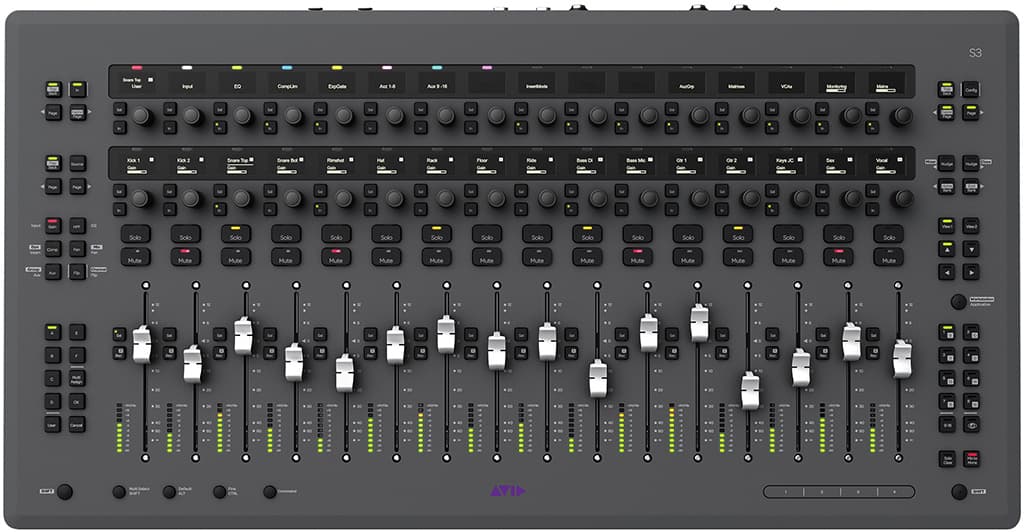
Review: Avid S3L-X Live System & Studio Controller
The S3L-X packs light, but can mix it up with the heavyweights.
Review: Guy Harrison
Avid unveiled the S3L live sound system a few years ago at the AES show to an industry poised with bated breath. Its bigger consoles had cemented Avid as a mainstay at big gigs and festivals far and wide, so the introduction of a cheaper, scalable networked system that could run showfiles and plug-ins just like its SC 48 and Control D consoles was sure to appeal to hire companies and end users. Two years down the track and there have been some major changes to the system in both hardware and software. But do these changes make the new, more flexible, S3L-X a home studio contender as well as a live sound system? Let’s take a look.
The S3L-X consists of three parts: the S3 control surface, E3 engine and Stage 16 I/O unit. These three components connect via Avid’s own low latency AVB network system to provide 64 channels of I/O at up to 48k. Each component has its own measure of I/O on board so in a live sound context their are options to connect playback devices or provide output splits at the FOH mix position on the S3 Surface and E3 engine and, of course, at the Stage 16 I/O. In the studio it means the S3 control surface can function as a four-input/six-output AVB Core Audio interface [see inset box]. You will also require a DVI-equipped monitor, which can be a touchscreen, and keyboard and mouse or trackball for navigating and naming.
Consistent across all Avid consoles is the onboard Venue software. But because the S3L systems have a different architecture to the older Profiles, D-Shows and SC48s, the software has been forked. It essentially looks and functions the same, so if you’ve ever worked on an SC 48 or Profile it will instantly feel familiar. But while those older consoles are on version three, the S3L systems are up to version 4.5. It’s a very powerful and well thought-out piece of software. Allowing control of everything from routing to plug-in assignment, snapshots, Pro Tools recording and playback, and everything in between. It’s very much an ‘if you can dream it, you can do it’ system but, as is always the trade off, there’s a learning curve and time needed pre-show for getting the show in order. But we’ll come back to the major changes to the Venue software, for now let’s tour the hardware.
SCRATCHING THE SURFACE
The S3 control surface is the biggest departure in form from anything else in the Venue console range, and its diminutive size will have some potential users worried. Rest assured Avid has gone to great lengths to make the S3 familiar to users of its bigger consoles. There’s an assuring quality of build to the S3, from its 16 Alps motorised touch-sensitive faders, to the reassuring click of every button, and pleasant resistance to the encoders which makes dialling in settings a simple and precise affair.
The E3 Engine is the DSP powerhouse driving the wheels. Housed in a 2U chassis the E3 contains HDX processing cards which allow you to run AAX DSP plug-ins. It’s an improvement in efficiency over the previous engine and is why the new S3L-X provides more plug-in power over the previous S3L System. An amount of I/O is also provided, four analogue ins and outs, as well as two stereo channels of AES digital connectivity.
The Stage 16 I/O provides 16 inputs and eight outputs, and is a clever box. It has a recessed IEC connector and switch, which I initially found a little troublesome to plug in, but a closer read of the literature made it all clear. The Stage 16 I/O can be rack mounted, but the rack ears also cleverly double as handles for use as a stage box. The recessed IEC allows it to be laid on its back, connectors up, like its conventional analogue equivalent. Nifty!
NEED TO KNOW

ALL AGE STAGE
I took the S3L-X System to an All Ages open mic night at a local venue. It’s typically a hectic night, the perfect baptism of fire for the S3L-X. It’s one of the few outlets for high-school rock bands in the area, so you always get a mixed bag of genres coming off stage. Though there is a common backline drum kit that makes changeover times bearable. As well as bands, on any given night there’s a good smattering of local singer/songwriter talent and the occasional oddity like the guy playing the coil spring from a car’s suspension and a wooden flute!
Knowing things would be coming at me thick and fast, I sat down the night before to program my showfile and test all inputs and outputs just to be safe. The S3L-X system is very straightforward to plug together with a redundant network ring joining stage boxes to the E3 engine. And the whole thing came packed in a couple of Pelican cases, showing it’s really unbelievably portable for the power.
With everything booted up, I was immediately digging some of the new features in the 4.5 software. Assigning I/O is no one’s idea of fun, but Avid has added a button which now allows you to ‘one-for-one’ patch entire devices, like a stage box. I won’t go through the entire file-building process, but suffice it to say it was straight forward and the basic show took no more than 30 minutes to build from scratch. I have had some previous experience on Venue software, but if you spent an hour reading the manual you would most likely achieve the same results.
I then waded into some of the Venue software’s new features. Pro Tools integration is now much tighter. You can switch all inputs to Pro Tools with a single button press for virtual soundchecks or you can also choose Pro Tools as an input on the Channel View screen, making it simple to run a mix of Pro Tools returns for backing tracks alongside your live inputs. This is all thanks to Avid’s implementation of AVB over a single network cable. To get the full throughput though, you must have a fairly new Thunderbolt-equipped Macintosh as apparently there is something in the Thunderbolt chipset the AVB network utilises, even though you’re not using this port for connectivity.
Lastly, I thought I should also take advantage of another new feature which is the ability to play media from a USB stick. So I decided to use this for my walk-in music. The new Media tab in the software provides a wealth of ways to actuate playback. The USB appears as a routing source so it can be very simple or, as I decided to make it, complex! Just to show off the level of control available I decided to create a snapshot that would load the playlist, play the tracks in a loop, set the fader level and unmute the USB input channel. Then I assigned that snapshot to a function key on the S3 Surface, and assigned another two functions to the Touch strip for stop and play. By the time I had Whole Lotta Love coming out of FOH with one flick of the touch strip, it sounded that much sweeter.


PLUG-IN BEAT
On the night the S3L-X didn’t skip a beat. I was a little apprehensive throwing myself in at the deep end with a gig that’s essentially a variety show, but the S3 control surface was up to the task and I was soon navigating it like a big console. You can assign channels to subgroups and VCAs simply and quickly. From there you can select the subgroup or VCA and all its routed channels will spill across the faders, which saves you paging around looking for things.
You get much of Avid’s plug-in inventory included with the S3L-X, including its Pro line, Reel Tape emulation and Smack! compressor. Of course, being a HDX engine, you have to use 64-bit AAX plug-ins, so no Waves straight out of the box. But you have a lot of choice from the likes of Softube, Sonnox, McDSP, Metric Halo, Crane Song, and more.
Once you’ve added them to your showfile they’re easily inserted from the Channel screen.
I didn’t think I would have much time to think about these but in practice I had 15 plug-ins inserted by the time the night was done. From the 1176 comps to some multi-band compression on my stereo bus, it was all falling to hand easily. It really is quite astounding how much power you have in such a small footprint. Although I was earlier questioning the black-on-black colour scheme of the S3, in use it wasn’t a problem and the tri-colour LEDs for navigation are a stroke of genius — saving you from ever wondering where you are on the console.

GOOD TO GO
I was impressed during my time spent with the Avid S3L-X system. While I probably didn’t use it to its full potential, it did what it had to, which was be quick to navigate and solid. It always felt good to the touch and I never found myself wishing I had more faders. The ability to integrate Pro Tools tracks and record shows at the press of a button is a bonus and is where this console really comes into its own. The fact you can record, virtual soundcheck and manipulate your snapshots means refinement is almost never-ending and is why the Venue series has won a lot of friends. It’s only made easier with the S3L-X’s ethernet AVB connection — no extra card required.
Another new feature which I’ll mention before signing off is automatic gain tracking. Now you just connect another E3 engine and S3 control surface to your network and presto, your monitor engineer can tinker away just like she’s on an analogue split. Avid S3L-X, what’s not to like!
















RESPONSES